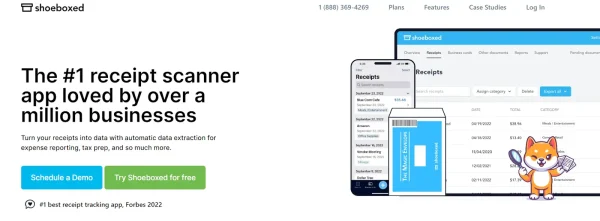An employee may incur expenses on behalf of their workplace by paying for business expenses out of pocket.
These expenses may be from employee luncheons, treating a client to dinner, business-related travel, or office supplies.
When employees use their finances for business expenses, they usually expect to be reimbursed by the company.
This reimbursement process starts when an expense report is created and submitted to the company.
In this guide, we’ll cover what an expense report is, why they’re needed, and how to create an expense report.
What are expense reports?

Expense reports are used to request reimbursement for money spent out of pocket by employees.
Expense reports are forms used to request reimbursement for expenses that an employee paid for with his or her own money.
These expenses are outlined and organized into categories such as mileage, meals, or office supplies.
Each expense is then itemized under associated categories.
That way, receipts that correspond with each itemized purchase can be submitted along with the expense report.
This expense report enables the business owner or finance department to easily detect how much money is being spent and what the money was spent on.
The expense report then has to be approved to receive a reimbursement.
Stop doing manual data entry 🛑
Outsource receipt scanning to Shoeboxed’s scanning service and free up your time for good. 30-day full money-back guarantee! ✨
Get Started TodayWhy are expense reports important?
An expense report is a critical piece of information for businesses.
Expense reports are an efficient way to track business spending, manage cost control, create company budgets, and ensure accurate reimbursements.
1. An expense report tracks business spending
Expense reports track business expenses so that the company can easily determine how much money is being spent and what the money is being spent on.
Tracking expenses help the business stay out of the red and aligned with its budget.
2. An expense report improves cost control
Expense reports are a reliable method for managing cost control.
Cost control begins with the review of expense reports.
This review tracks the business expenses and results in a better understanding of the money being spent in various places.
This way you can easily determine which categories are costing you the most money.
Expense reports make it easier to come up with strategies on how to minimize overspending in certain areas of the company.
3. An expense report helps create budgets
Staying within the limits of a budget is the key to any successful business.
Expense reports help create a more accurate and realistic budget.
You can use expense reports to find the average cost of business expense categories from previous years and base your new budget on those numbers.
4. An expense report ensures accurate reimbursements
Accurate reimbursements are important to the employer and the employee submitting the expense report.
If an employee has used his or her money to pay for business expenses, then it’s only fair that the business reimburses the employee for the same amount (as long as it falls within the company expense policy).
On the other hand, employers want to make sure the request is valid and accurate so that the business is not paying more than it owes.
5. An expense report establishes a standard process
Expense reports establish and standardize the process of what can and can’t be expensed and how expenses are reported.
This way employees are aware of what expenses are likely to be reimbursed—and which ones aren’t—before putting their finances on the line.
6. An expense report is an efficient method for validating expenses
Expense reports are an efficient method for legitimizing expenses incurred by employees.
Having an expense report makes it easy for employers to see exactly how much money is being spent, where it’s being spent, and if it complies with the business expense policy.
With paper receipts attached, expense reports are supporting evidence of where, when, and how the expenses were incurred.
7. An expense report validates the associated tax deduction
Many of the expenses incurred by employees are tax deductible.
However, to deduct them, you have to have supporting evidence, such as receipts, to prove that the expenses are legitimate.
Expense reports help keep track of—and provide the needed supporting evidence for—deductible expenses.
This makes deducting expenses on the business tax return a much simpler process.
What’s included in expense reports?

Expense reports should include the information your business needs to legitimize the expense.
There is basic information that should be included in every expense report.
A list of the essential information is found below:
Employee details such as name, contact information, and department
Amount and date of each receipt that correlates with the attached receipt
The expense type such as mileage, meals, or office supplies
From whom the expense was incurred
Where the expense occurred including business name and location
The client or project the expense is related to
Category or account of purchase
Any additional details about the expense
Subtotal for each category of expenses
Total expense cost including tax
For some examples of expense reports, see this article: Expense Report Templates Google Sheets: Top 4 Picks
What is the process for reporting expenses?
Expense reports are usually submitted as monthly expense reports or every quarter.
Once the report is submitted, it’s reviewed for accuracy and legitimacy.
The report is then either approved or rejected based on company policy.
If approved, the reimbursement is issued. The reimbursement is then recorded as a business expense, and all reports and receipts are organized and stored for any potential audits.
Yearly expense reports are used to summarize the categories of deductible expenses on the business’ tax return.
1. What are manually created expense reports, and how are they used?
Expense reports are either created manually through an expense report form or by using expense report software.
Most businesses create an expense report template for their employees because it makes tracking expenses simpler.
Creating expense reports also ensures that the company is getting the necessary information from their employee.
In the expense report template, the employee will include the following:
Their name
Contact details
Date
Department
Expenses are recorded in chronological order along with details about the expense.
The employee then calculates the subtotal of all categories and the total including tax.
Once the associated receipts have been attached, the report is submitted for approval.
Watch the video below for a quick expense report template tutorial:
Expenses in Excel – Tutorial – [Create it in just 12 minutes] by Mr. SpreadSheet2. What is expense reporting software, and how is it used?
Those who find manual expense reporting too tedious and time-consuming turn to automated expense reporting.
It’s not uncommon for businesses to incur many business expenses, and an expense management system makes creating, recording, and tracking reports much easier.
Reports can be processed on the go with apps, and bank accounts, debit cards, and credit cards can even be connected to the expense reporting software.
Transactions from the statements are then converted to expenses.
Software applications will walk you through the mandated fields, the business expenses incurred will be grouped into a report, and then you can submit expense reports with the click of a key.
Are there any options for managing receipts?

Shoeboxed can help manage and organize business-related receipts.
Shoeboxed is a great option for managing and organizing receipts.
Shoeboxed is both a receipt-scanning app and a receipt-scanning service.
You can either put your paper receipts in their Magic Envelope and mail them to their facility for processing or use their mobile app for uploading receipts.
Either way, your business receipts are turned into categorized, searchable, and editable data for expense reporting and tax prep.
Turn receipts into data for tax time ✨
Try Shoeboxed’s systematic approach to receipt tracking for tax season. 30-day full money-back guarantee!
Get Started TodayWhat are the benefits of expense reporting software?
There are many benefits to using expense reporting software.
Some of these benefits include the following:
Automates generating reports, the submission process, and the approval and rejection process
Automatically sends up red flags if expenses are not compliant with company policy
Weeds out expense reimbursement fraud
An efficient process for expense tracking
It makes cost control less tedious with the analytical reports
Frequently asked questions
What are the IRS rules for expense reports?
General rules on employee expenses for IRSC employees include the following:
• The employees should provide contextual information about the incurred expenses, like the amount, date of receipt, and purpose
• Expenses are due within 60 days after expenses were collected
• You need to have supporting evidence, such as a receipt, to back up the expense
How do companies do expense reports?
Generally, an expense report reflects the costs incurred by a company employee whether through a company credit account or through a company cash advance. Using software for expense management can make the expense reporting process easier for users.
How are expense reports used by businesses?
Businesses use expense reports to track expenses, legitimize employee expenses, and claim valuable tax deductions. Businesses that keep a detailed record of these expenses have an easier time claiming tax deductions. All they have to do come tax time is calculate the monthly totals for each expense category.
In conclusion
Expense reports are vital to employees that use their own money for business-related expenses.
These reports are also important to employers who reimburse employees for the money they spend.
Knowing how to create expense reports for your business will help you keep track of the money going out of your company and better prepare for future spending.
Caryl Ramsey has years of experience assisting in bookkeeping, taxes, and customer service. She uses various accounting software for setting up client information, reconciling accounts, coding expenses, running financial reports, and preparing tax returns. She is also experienced in setting up corporations with the State Corporation Commission and the IRS.
About Shoeboxed!
Shoeboxed is a receipt scanning service with receipt management software that supports multiple methods for receipt capture: send, scan, upload, forward, and more!
You can stuff your receipts into one of our Magic Envelopes (prepaid postage within the US). Use our receipt tracker + receipt scanner app (iPhone, iPad, and Android) to snap a picture while on the go. Auto-import receipts from Gmail. Or forward a receipt to your designated Shoeboxed email address.
Turn your receipts into data and deductibles with our expense reports that include IRS-accepted receipt images.
Join over 1 million businesses scanning & organizing receipts, creating expense reports, and more—with Shoeboxed.
Try Shoeboxed today!



